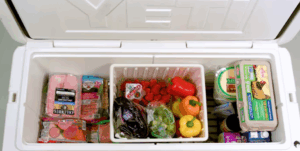Packing for a weekend adventure in the Gila Wilderness of Nevada requires careful planning to balance comfort, safety, and self-sufficiency. The Gila region, known for its rugged landscapes, remote trails, and unpredictable weather, demands that adventurers be well-prepared for both the challenges of wilderness travel and the beauty that comes with true solitude. Whether you’re hiking, camping, or exploring by vehicle, the key to a successful weekend trip lies in bringing essential gear, packing efficiently, and being ready for a variety of conditions.
The Basics- Shelter, Food, Water
 Start with the basics: shelter, sleep, and clothing. A sturdy, lightweight tent suitable for variable weather is essential, along with a ground tarp or footprint for protection against moisture. Pack a sleeping bag rated for the expected nighttime temperatures and an insulated sleeping pad for comfort and warmth. Clothing should follow the layering principle—moisture-wicking base layers, insulating mid-layers such as fleece, and a waterproof outer shell. Even in Nevada’s desert wilderness, temperatures can drop sharply at night, so pack a beanie and gloves. Sturdy hiking boots, extra socks, and breathable trail clothes will make long treks more comfortable. Don’t forget a hat and sunscreen to protect against the intense desert sun.
Start with the basics: shelter, sleep, and clothing. A sturdy, lightweight tent suitable for variable weather is essential, along with a ground tarp or footprint for protection against moisture. Pack a sleeping bag rated for the expected nighttime temperatures and an insulated sleeping pad for comfort and warmth. Clothing should follow the layering principle—moisture-wicking base layers, insulating mid-layers such as fleece, and a waterproof outer shell. Even in Nevada’s desert wilderness, temperatures can drop sharply at night, so pack a beanie and gloves. Sturdy hiking boots, extra socks, and breathable trail clothes will make long treks more comfortable. Don’t forget a hat and sunscreen to protect against the intense desert sun.
Navigation & Safety Preparations
 Navigation and safety tools are equally critical. Carry a detailed topographic map, compass, and GPS device or app with offline maps, since cell service is limited in much of the Gila Wilderness. A first aid kit, whistle, multitool, and headlamp with spare batteries should be easy to reach in your pack. It’s also wise to bring a small repair kit for tents and gear, as well as a fire-starting kit including waterproof matches or a lighter. Water is one of the most important considerations—bring enough to sustain your group for the duration, or pack a reliable water filter or purification tablets if you’ll be refilling from natural sources.
Navigation and safety tools are equally critical. Carry a detailed topographic map, compass, and GPS device or app with offline maps, since cell service is limited in much of the Gila Wilderness. A first aid kit, whistle, multitool, and headlamp with spare batteries should be easy to reach in your pack. It’s also wise to bring a small repair kit for tents and gear, as well as a fire-starting kit including waterproof matches or a lighter. Water is one of the most important considerations—bring enough to sustain your group for the duration, or pack a reliable water filter or purification tablets if you’ll be refilling from natural sources.
Food Storage & Maintaining Safe Food Temperatures
Food and storage require extra attention, and this is where a cooler becomes a key piece of gear. For a short weekend trip, you can choose between a budget cooler and a high-end cooler depending on your needs. A budget cooler, typically made of lightweight plastic with basic insulation, is cost-effective and perfectly suitable for shorter adventures where you’ll only need to keep food cold for a day or two. They’re easy to carry, simple to clean, and often compact enough to fit neatly in a vehicle or at the base of a campsite. However, they tend to lose their chill faster, especially in the Nevada sun, so you’ll need to pack plenty of ice or frozen water bottles to maintain safe food temperatures.
 In contrast, a high-end cooler, such as those made by brands like Yeti or Pelican, offers superior insulation and ice retention for extended trips or hotter conditions. These coolers can keep ice frozen for several days, making them ideal for more remote adventures where resupplying isn’t possible. They also tend to be more durable, with heavy-duty latches and bear-resistant construction—an advantage in rugged terrain. The downside, of course, is the higher price and heavier build, but for those who camp often or spend long stretches off-grid, the investment pays off in reliability and performance.
In contrast, a high-end cooler, such as those made by brands like Yeti or Pelican, offers superior insulation and ice retention for extended trips or hotter conditions. These coolers can keep ice frozen for several days, making them ideal for more remote adventures where resupplying isn’t possible. They also tend to be more durable, with heavy-duty latches and bear-resistant construction—an advantage in rugged terrain. The downside, of course, is the higher price and heavier build, but for those who camp often or spend long stretches off-grid, the investment pays off in reliability and performance.
Round out your packing list with personal items like biodegradable soap, a quick-dry towel, extra trash bags for packing out waste, and a small camping stove or grill for cooking. Bring a journal or camera to capture the experience, and always follow Leave No Trace principles to protect the delicate wilderness. With thoughtful preparation—and the right cooler for your style of travel—you’ll be ready to enjoy a safe, rewarding weekend immersed in the natural beauty of the Gila Wilderness.